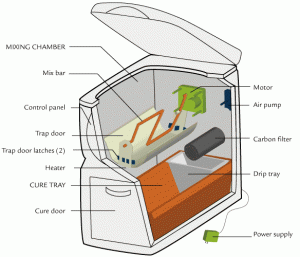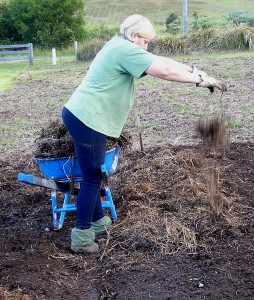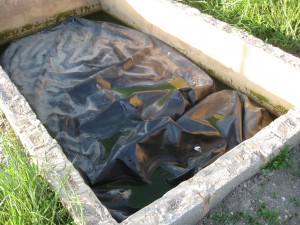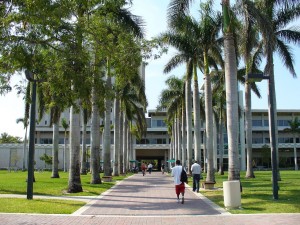Posted April 30, 2015
By DIYA VASUDEVAN
During the Clinton Global Initiative University (CGIU) 2015 that took place at the University of Miami this spring, a major point that was emphasized during the meeting was the sustainability of the campus.
Heading this presentation was the sustainability manager Teddy Lhoutellier. He touched upon many projects and investments that certified the campus as a green and sustainable one. However, when it came to composting, the university fell short.
Click to view an audio slideshow about UM composting by Diya Vasudevan.
Composting is essentially nature’s way of recycling and is the biological process (and in this case with the aid of humans) of breaking down organic, biodegradable waste and using it to create a humus-like substance.
This can be used over soil, to make it nutrient rich and provide it with the best climate/health for the growth for plants. Waste that can be used for composting is usually food waste, manure, paper and coffee grounds.
On a medium-sized university campus that has two dining halls, (Hecht-Stanford and Mahoney) boasting as many as 2,000 freshmen each year, the amount of food waste can be quite large.
Lhoutellier did not give an explanation as to why composting was not a part of UM’s green initiative, but did in great detail discuss the availability of recycling bins on campus.
Lhoutellier stated that “composting is on the agenda, we just don’t know whether it will go into action in a year or two years. We, however, do have a biodigester in the Hecht-Stanford dining hall.”
A biodegester essentially liquefies all the food waste in order to speed up the process breaking it down. The food waste is put into an airtight chamber where it undergoes anaerobic digestion in order to make it more biodegradable.
Lhoutellier, however, went on to elaborate that this process was “only for pre-consumed food, which is basically whatever food is left in the kitchen that has not been consumed. In the future, we hope to have something that accommodates for both pre-consumption and post-consumption food.”
Therefore, leftover food waste from consumed food was still not being dealt with at present.

Invessel Composter (Photo courtesy of People Powered Machines).
Although Lhoutellier stressed the complexity of composting on campus in regards to funding and whether the composting would be carried out by the university itself or by an outsourced company, there have been other universities that have managed to successfully compost their waste.
In 2009, Ohio University became the first university with the largest in-vessel compost facility in the country, which they were only able to achieve due to the grant from Ohio Department of Natural Resources that allowed the institution to purchase the in-vessel composting system.
“All the green waste goes to the mulching area,” Lhoutellier stated.
This means that all the decaying leaves and bark, and so forth, from the abundant plants and trees on campus is spread back all around the soil in order to enrich it and maintain its health.
The chair of the UM Student Government Eco Board, Nika K. Hosseini, thinks composting is a promising program.
“We are very excited for the prospect of composting in the near future. It’s a great way to lower our waste output while simultaneously benefiting the surrounding environment through rich soil. There are currently biodigesters behind the Hecht-Stanford dining hall that produces grey water from food waste which is a great start,” Hosseini stated.
The CGIU initiative in itself encouraged students to take action on issues of importance to them whether it was environmentally or socially.
One such student, Robert Rankin from the College of Arts and Science, expressed the importance of community composting at the university. His commitment to action was as stated on the University of Miami CGIU page:
“To implement the practice of sustainable composting in the University of Miami community. Such a plan will help reduce landfill, reduce fertilizer usage, and promote a greater system of reuse. Before beginning the composting, advocacy is necessary – the entire university must be educated on what can and what cannot be composted: if a significant number of people dispose of non-compostable items in the compost bins, it could have catastrophic effects. Eventually compost bins will be placed on a few select floors within the residence halls as a test group,” Rankin wrote.
Rankin’s commitment details the delicate nature of composting and the importance of carrying it out in the right way if the university intended it to be a community commitment.
This commitment to action has not been implemented yet however the university shows the presence of new recycling bins all around campus.
The University of Miami shows promise in terms of achieving its sustainability aims. The commitment to action by President Donna Shalala in 2007 details that every new building is to be Leadership in Energy and Environmental Design (LEED) certified, meaning that it is extremely sustainable and energy efficient. The new Frost School of Music building boasts platinum certified title, with solar paneled roofs and proposed rainwater systems.
The university certainly is not completely green and environmentally sustainable. However, as Lhoutellier put it, “it’s getting there.”



